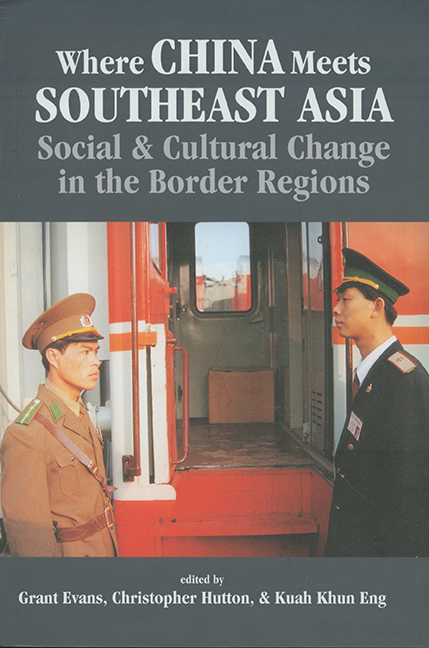Book contents
- Frontmatter
- Contents
- Contributors
- Map
- Introduction: The Disappearing Frontier?
- 1 Where Nothing Is as It Seems: Between Southeast China and Mainland Southeast Asia in the “Post-Socialist” Era
- 2 The Southern Chinese Borders in History
- 3 Ecology Without Borders
- 4 Negotiating Central, Provincial, and County Policies: Border Trading in South China
- 5 The Hmong of the Southeast Asia Massif: Their Recent History of Migration
- 6 Regional Trade in Northwestern Laos: An Initial Assessment of the Economic Quadrangle
- 7 Lue across Borders: Pilgrimage and the Muang Sing Reliquary in Northern Laos
- 8 Transformation of Jinghong, Xishuangbanna, PRC
- 9 The Hell of Good Intentions: Some Preliminary Thoughts on Opium in the Political Ecology of the Trade in Girls and Women
- 10 Cross-Border Mobility and Social Networks: Akha Caravan Traders
- 11 Cross-Border Links between Muslims in Yunnan and Northern Thailand: Identity and Economic Networks
- 12 Trade Activities of the Hoa along the Sino-Vietnamese Border
- 13 Cross-Border Categories: Ethnic Chinese and the Sino-Vietnamese Border at Mong Cai
- 14 Regional Development and Cross-Border Cultural Linkage: The Case of a Vietnamese Community in Guangxi, China
- 15 Women and Social Change along the Vietnam-Guangxi Border
- Index
4 - Negotiating Central, Provincial, and County Policies: Border Trading in South China
Published online by Cambridge University Press: 21 October 2015
- Frontmatter
- Contents
- Contributors
- Map
- Introduction: The Disappearing Frontier?
- 1 Where Nothing Is as It Seems: Between Southeast China and Mainland Southeast Asia in the “Post-Socialist” Era
- 2 The Southern Chinese Borders in History
- 3 Ecology Without Borders
- 4 Negotiating Central, Provincial, and County Policies: Border Trading in South China
- 5 The Hmong of the Southeast Asia Massif: Their Recent History of Migration
- 6 Regional Trade in Northwestern Laos: An Initial Assessment of the Economic Quadrangle
- 7 Lue across Borders: Pilgrimage and the Muang Sing Reliquary in Northern Laos
- 8 Transformation of Jinghong, Xishuangbanna, PRC
- 9 The Hell of Good Intentions: Some Preliminary Thoughts on Opium in the Political Ecology of the Trade in Girls and Women
- 10 Cross-Border Mobility and Social Networks: Akha Caravan Traders
- 11 Cross-Border Links between Muslims in Yunnan and Northern Thailand: Identity and Economic Networks
- 12 Trade Activities of the Hoa along the Sino-Vietnamese Border
- 13 Cross-Border Categories: Ethnic Chinese and the Sino-Vietnamese Border at Mong Cai
- 14 Regional Development and Cross-Border Cultural Linkage: The Case of a Vietnamese Community in Guangxi, China
- 15 Women and Social Change along the Vietnam-Guangxi Border
- Index
Summary
China has a long border, which it shares with numerous neighbours. In the northeast are the Jilin and Liaoning provinces, both sharing a border with North Korea; in the northwestern region Xinjiang shares a border with Russia; Mongolia is its northern neighbour; Heilongjiang has Russia as its northern neighbour; the west has Kashmir, Nepal, Sikkim, and Bhutan as its neighbours; the southeast has India; and the southwest provinces of Yunnan and Guangxi share a border with Myanmar, Laos, and Vietnam.
Traditionally, mountain ranges have formed natural barriers on long stretches of China's border. These mountains have obstructed communication and social interaction among the many neighbours that live in proximity to one another. Increasingly, however, it is the political boundary that serves to artificially segregate the people living along the border, irrespective of their cultural background. Thus, some scholars argue for the need to explore and study cultural areas instead of political areas. Despite the tight control over border regions, those living along the borders have continued to communicate, interact, and trade with one another, albeit on a small and restricted scale.
Since the communist victory in the civil war in China in 1949, the border regions have been closely guarded and tightly sealed to prevent outside influences from entering China. Apart from political considerations, there were fears that cultural and other forms of social pollution would enter China and thereby upset the morals of the Chinese people. The border regions remained closed until the 1980s. After the death of Mao Zedong in 1976, China under Deng Xiaoping embarked on a new direction of economic liberalization and modernization. This was the 1978 Reform Era, which has become a new watershed for China's economic development. The 1978 Reform has provided the border regions with a legitimate excuse to reopen their borders for trade with neighbouring countries.
The 1980s and 1990s are important decades in the development of the economy of the border regions.
- Type
- Chapter
- Information
- Where China Meets Southeast AsiaSocial and Cultural Change in the Border Regions, pp. 72 - 97Publisher: ISEAS–Yusof Ishak InstitutePrint publication year: 2000

